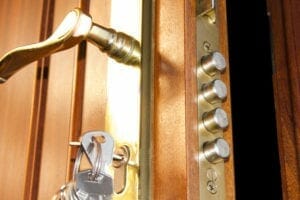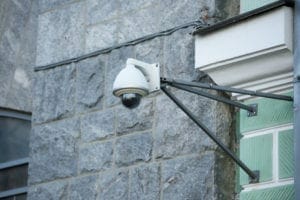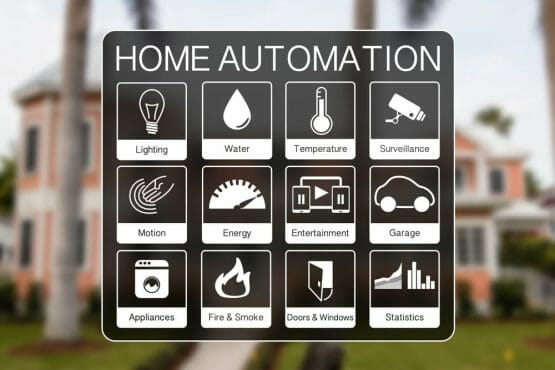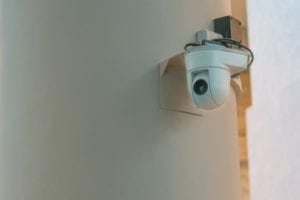Quick Navigation
The words “home security” has become so broad that it can feel overwhelming. But, the truth is, steps, hints, and tips are easier to follow than just throwing two words into Google and hoping for the best.
We all strive to feel safe in our own homes. It sometimes comes in easy-to-do methods, and others require layers of surveillance and structure.
Let’s take a look at the options that may work best for your wants and needs.
10 DIY No-Cost Basics — Home Security

No-cost steps are the first line of defense when it comes to protecting personal property. Preventing a break-in literally starts at home. You have the power to be your own security guard.
- Hide Valuables — The less a potential burglar sees in a home, the less he will want to break inside. Keep valuable items out of sight. It also applies to things we naturally keep outdoors, like bicycles and grills. A locked garage is a good option to keep items from merely disappearing.
- Hidey Hole — A spare key is part of life. We never know when we will need someone to check in on our family or homes. But, be careful where you keep it. It might be best to entrust it with a neighbor.
- Foliage — Keep shrubs and bushes pruned so no one can use them for concealment purposes. Trimming trees is also an excellent plan to limit the ability to climb to the second floor.
- Lived In Look — Bad guys can tell when people are not at home — work or trip. Leaving on lights or having a neighbor park their car in your driveway will throw off someone looking to get inside your home.
- Tip: The local police department will extra patrol a location with a quick phone call.
- Blinds, Drapes, Curtains, Oh My — The coverage of windows keeps people from peaking in and secures privacy, but more so, it takes away the temptation for people who spot something and decide it is theirs.
- Signage — You can make your own signs to throw off an intruder even if you don’t have a security system.
- Examples — Beware of dog or a well-made security sign
- Lists — Making lists of valuables and important documentation is not only great for potential break-ins; it is an easy way to keep up with your things.
- Changing Codes — An easy step you can take towards better security is changing your codes on a regular basis. Whether on the front door or your gun safe, freshen up the entry codes for everyone’s sake.
- Social Media — Be wary of what you post on social media. Perpetrators find hints of work routines and planned vacations to decide on an optimal break-in scenario. Don’t give them the upper hand by advertising when you’re not at home.
Breaking Down Home Security
The no-cost tips are a step in the right direction. But, typically, they are not enough to keep the more persistent intruders at bay.
We are going to guide you through some more measures you can take to protect yourself, your family, and your property.
#1. Locks

It is not paranoia to change the locks throughout a house on a regular basis. Copying keys are as easy as a manual machine in your local hardware store.
Bettering a window or a sliding door lock is sometimes as easy as drilling a hole and putting in a pin lock. Creating better jambs is also an efficient approach to add more security to entryways.
For better front and back door security, reinforcing them with strike plates protects against someone just kicking in the door. Deadbolt locks are okay to have, but picking them is a skill some thieves have in their arsenal.
- Hint for Later — Smart devices and automation exists to level up on the window and door security.
#2. Pets

The suggestion that a dog helps protect a house is actually a fact.
Smaller dogs tend to yap and bring attention to possible intruders and trespassers. But, in the end, a tiny pup will not do a whole lot to threaten a bad guy.
Larger dogs with a bellowing bark not only alert to people on your property, but few burglars will want to test and see if they bite.
However, with dogs come doggy doors; make sure to secure them with a lock to avoid someone sneaking through even a small opening.
- Tip: Leave pet toys outside in the yard as a warning to potential criminals.
#3. Light and Motion

Keeping a porch light on, even during the day, is a good first step when lighting up dark spaces, a criminal can take advantage of.
Also, consider motion-controlled lights because they are a big help and inexpensive. If someone steps into your yard, your property will light up like a Christmas tree.
- Tip: Brightness gives the impression someone is at home.
Motion detecting light bulb cameras are an inexpensive option. They will light up and record the detected activity.
Even more useful are smart bulbs that are automated on a schedule and detect motion. You will never forget to turn them on to break up the darkness of night or come on during intervals during the day.
More Home Automation — Doorbell Alarms, Driveway Alarms, and Smart Locks

Doorbell alarms are flooding the home security market. The price tags attached range from cheap to expensive.
Video doorbells work as diverse peepholes, visitor alerts, and are a simple solution to keep someone from sneaking up to the front door.
Some people choose a monitoring service with their smart doorbell, while others decide to monitor the activity themselves. Either way, it is a step in avoiding a front entry break-in.
- Tip: About 32% of intruders come through the front door.
Do you want to know that someone is coming to the door before they get there? A driveway alarm uses sensors to detect movement and sends alerts to a property owner.
Finally, smart locks and keyless deadbolt kits are new additions to home automation. It eliminates the need for extra keys and works on a schedule.
Even more importantly, they detect when you’re coming in and out and lock by themselves, so you never have to worry about the kids forgetting to lock up the house again.
The Larger Picture — Security Systems

It is not that security systems are hard to understand; it is the insane amount of options to choose from that quickly gets overwhelming. You have a battery powered security camera that you can find at your local hardware store. Then at the top, you have a 4k security camera system with DVR storage with monitoring.
- First, let’s talk about the smaller wireless alarm systems.
Burglars hate getting made with loud noises. It brings attention to their misdeeds really fast. They are not as robust as pro-installed systems with monitoring services, but they do serve as a one-layer deterrent.
You put magnetic sensors or strip alongside the small alarm. When doors or windows open, breaking the contact, it triggers a shrill warning to scare off a criminal hopefully.
- The next step up is DIY home security alarms that come with kits.
The DIY setup usually includes magnetic strips and motion detectors. What makes them significantly better than simple alarms is the ability to use a phone app to get alerts and control it from anywhere.
One of the largest draws is that you can install it yourself. It eliminates a fee for a professional security system installer. The process of connecting on to your secure WiFi is an easy task, too.
However, the cost is still there if you need it to be. Monitoring services are available if you worry about missing out on alerts. But you can also choose to be your own watchdog.
- When leveling up from alerts and alarms, it takes installing cameras.
Camera security systems still need a safe WiFi connection and someone to monitor it, but they, not only sense danger, it records it, too. The video ranges from snippets to live feeds, depending on the capability.
You still have the ability to install the system yourself, but you may find a monitoring service is the best plan for keeping up with movement detections and alarm activations.
Wireless cameras come in the battery variety or using a solar powered security camera.
- Side Note: Local law enforcement and fire departments do fine homeowners for excessive false alarms.
- For optimal security, professional installers will develop a corner by corner and window by window plan for cameras, sensors, motion detectors, and more.
A Monitoring service is a recommendation because you want to get the best bang for your buck. When triggered, the security company will call your local authorities if they cannot get ahold of you.
The best systems work with already existing home automation. That sort of protection blankets your home from the driveway to your property lines.
Best Outdoor Wireless Security Camera System with DVR

Break-ins begin outside, be it windows or doors. But, let’s consider for a moment that you suspect someone you know of stealing from the inside or sneaking around your property.
Outdoor wireless security cameras that store on a DVR allow a homeowner to view recorded footage that did not come from a motion detector trigger. It gives a bigger picture of any and all activity.
Sure, you can use your phone app throughout the day to live stream or even a monitoring service to pick up the slack, but some activity does not register as appropriate warnings.
Things we like:
- Weatherproof cameras
- Clear Night Vision Capability
- Wide Range of View
- DVR Storage
- Smartphone Apps
4 Answers to Everyday Security Concerns

We covered the myriad of ways to create layers upon layers of home protection and safety. But, the truth is, no one can afford it all at once.
We are going to break down the basics by answering common questions and concerns.
#1. How do I protect my home from intruders?
Intruders are worry and fear for everyone because no one is immune to the invasion of space, safety, and privacy.
The thing about intruders is that they are not always after valuables. They also do not care if the sun is out or not.
We’ve covered how diverse home protection is. Let’s break down a single, simple measure you can take.
Windows
Windows act like eyes to the soul of a home. Taking steps to close them down with shutters or curtains will keep out prying eyes and reduce the temptation to possible intruders.
Low-cost options for protecting them are window specific security film and better locks.
4 Types of Window Locks:
- Keyed Lock — They are literally what they sound like. Keyed locks are like deadbolt locks but work with a key.
- Ventilating Lock — Fresh air is important to people. Many of the ways to secure windows limits ventilation, but with these, there is a pin that allows a window to open, but with a layer of security attached.
- Locking Pin — People have double-hung windows and need a way to toughen them up. A locking pin sticks a window in place to keep it closed.
- Flip Lock — It is a piece of hardware that windows tend to come with, and are the most common.
More expensive options are out there for window security. Shatterproof glass and heavy metal bars will keep intruders from entering through them, for sure.
#2. How can I make my home more secure?
We don’t wake up one day and cover all the safety precautions according to some protocol. But, taking one step at a time not only keeps the cost down, but it helps to make sense of overall home security. No one home or family budget is the same.
Finding a starting point and planning the end game makes the entire process smoother and cost-efficient.
10 Summarized Steps
- Reinforce and secure all door
- Lock and reinforce windows and sliding glass doors
- Create a bright outer perimeter, porch lights, and floodlights
- Remember to secure the garage
- Choose and install a security system
- Make sure the WiFi network is secure
- Find and fix potential hiding spots
- Consider cameras
- Use safes for guns, valuables, and paperwork
- Work towards full home automation
#3. How do most burglars get in?
Burglary is a real threat. The average price tag on a loot job by a burglar was nearly $3,000 in 2018. According to the FBI, the overall grand total in that same year was almost $3.5 billion.
A quick exercise can help you think like a pilferer and stop them before they even get the idea.
Walking the perimeter of your property gives you an idea of any weak spots that someone can take advantage of. It also signals which bushes, shrubbery, and trees require trimming to reduce shade and shadows.
- Hint: A simple game of hide-and-seek around your landscape helps give away potential hiding places.
Burglars look for weaknesses. Secluded neighborhoods, dead ends, and cul-de-sacs are a few places they target first. Well-kept yards and expensive cars will draw them even further in.
But, don’t avoid living in the house of your dreams or mowing your grass to prevent a break-in. Just think like an intruder when you walk around your landscape.
- Are your windows closed and locked?
- How well are your doors locked and secured?
- If you have a doggy door, is it locked?
- How secure are your garage and sheds?
Take a stroll around the exterior and test every point of entry. Repeat the walk around every so often.
- Tip: The popular entry points for bad actors are the front and back door and the garage.
#4. How do I thief-proof my house?
Thieves come in a variety of shapes and sizes. Meaning, they are all looking for different things.
Removing the lines of temptation is a quick start to thief-proofing your home. Locking up things like bicycles and lawn equipment might just be what it takes to keep a thief from even stepping on your property.
An upsetting statistic is that once you’ve been a burglary victim, the chances of it happening again skyrockets. Thieves know that a homeowner will replace the items stolen with new models. Avoiding the first time will safeguard against the second, third, and so forth.
5 Helpful Tips to Thief-Proofing Your Home
- Know who is coming and going from your house. Keep track of contractors, pest control, and even landscapers.
- Sliding doors are a tricky thing when it comes to barring thieves from entering. The broom handle trick might work for a while, but shrieking alarms and stronger glass are the better approaches
- Avoid putting receipts, boxes, or discarded valuables on the curb.
- Do not share vacation plans on social media. It also means just to wait to post pictures of out of town adventures.
- Motion lights go a long way to stopping movement on your property. Whether it is neighborhood kids or a catnapper, lighting up the place will shoo them away or record their misdeeds.

